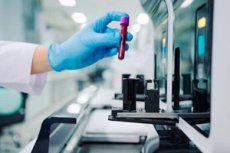Nye publikasjoner
Ny blodprøve sporer hjernens restitusjon etter hjernerystelse
Sist anmeldt: 02.07.2025

Alt iLive-innhold blir gjennomgått med medisin eller faktisk kontrollert for å sikre så mye faktuell nøyaktighet som mulig.
Vi har strenge retningslinjer for innkjøp og kun kobling til anerkjente medieområder, akademiske forskningsinstitusjoner og, når det er mulig, medisinsk peer-evaluerte studier. Merk at tallene i parenteser ([1], [2], etc.) er klikkbare koblinger til disse studiene.
Hvis du føler at noe av innholdet vårt er unøyaktig, utdatert eller ellers tvilsomt, velg det og trykk Ctrl + Enter.

En studie ledet av Monash University har funnet ut at en blodprøve nøyaktig kan identifisere de pågående effektene av sportsrelatert hjernerystelse og bidra til å avgjøre når det er trygt å gå tilbake til trening.
Forskerne målte nivåene av to hjernespesifikke proteiner i blodet til 81 spillere fra Victorian Amateur Football Association (VAFA) som hadde fått hjernerystelse, og sammenlignet dem med 56 spillere som ikke hadde fått hjernerystelse.
Ved å spore nivåer av biomarkører i blodet over tid, overvåket de hvor lang tid det tok for spillernes hjerner å komme seg, også kjent som «nevrobiologisk restitusjon», for å avgjøre når det kan være trygt å returnere til spill uten økt risiko for skade.
Frem til nå har det ikke eksistert veletablerte verktøy for å spore nevrologisk restitusjon etter idrettsindusert hjernerystelse.
Denne kohortstudien, publisert i JAMA Network Open, undersøkte dynamikken til to hjernecelleproteiner, glial fibrillary acidic protein (GFAP) og neurofilament light protein (NfL), som frigjøres i blodet etter hjerneskade.
Selv om teamets tidligere forskning har vist det diagnostiske potensialet til disse biomarkørene i blodet, hadde denne studien som mål å vise hvordan nivåene deres endret seg over tid hos spillere med hjernerystelse.
Det mest slående funnet var mangfoldet av biomarkørendringer på tvers av individer: mer enn 20 % av hjernerystelsene viste signifikante og vedvarende økninger i både GFAP og NfL, som forble forhøyet sammenlignet med uskadde fotballspillere i mer enn fire uker.
Personer med disse ekstreme biomarkørendringene hadde betydelig større sannsynlighet for å miste bevisstheten etter et hodestøt.
Studieleder og hovedforsker ved Monash Trauma Group, dr. Stuart McDonald, fra Monash Universitys School of Translational Medicine, sa at selv om teamet hans og andre hadde undersøkt disse biomarkørene tidligere, var dette første gang en fullstendig profil av progresjon etter skade hadde blitt registrert.
«Det unike med denne studien er ikke selve målingen, men hvor mange ganger og hvor konsekvent vi gjorde det – åtte ganger over seks måneder på tvers av 137 idrettsutøvere», sa Dr. McDonald. «Med svært lite manglende data, på grunn av vår unike tilnærming med å besøke deltakerne hjemme, kunne vi få en detaljert profil av biomarkørbaner over tid.»
«Vi har vist at GFAP-nivåene i blodet er forhøyet hos de aller fleste hjernerystelsesrammede idrettsutøvere etter 24 timer, og vi jobber nå med å få denne sårt tiltrengte diagnostiske testen godkjent for bruk i de kommende årene.»
«Det neste viktige steget er å demonstrere hvordan og når vi bør måle disse to proteinene som biomarkører for tilbakekomst til sport. Funnene våre bringer oss nærmere å gjøre dette til en realitet.»
«Vår visjon er at serielle målinger av disse proteinene skal integreres i klinisk praksis, og veilede beslutninger om tilbakevending til lek basert på både symptomer og nevrologisk bedring.»
